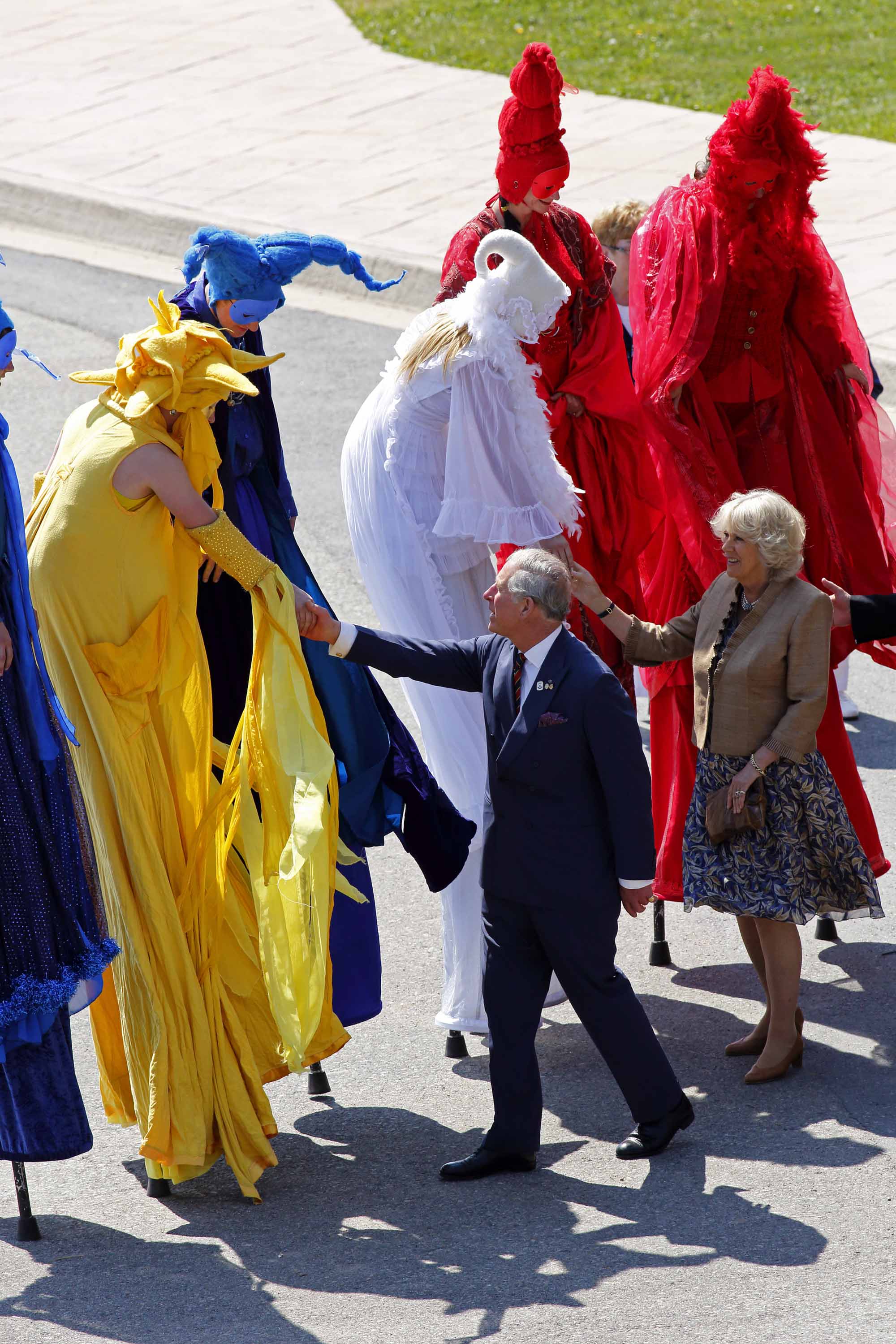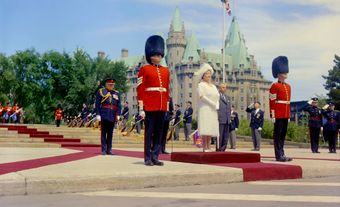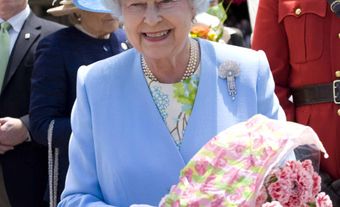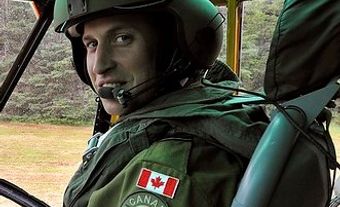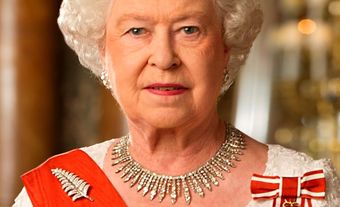His Majesty King Charles III (formerly Prince Charles), King of Canada, the United Kingdom and 13 other Commonwealth realms (born 14 November 1948 in London, United Kingdom). Charles is the eldest son of Her Majesty (HM) The Queen (1926–2022) and His Royal Highness (HRH) The Duke of Edinburgh (Prince Philip) (1921–2021). Charles became King on 8 September 2022 after the death of his mother, Queen Elizabeth II.

Birth
Prince Charles Philip Arthur George was born on 14 November 1948 at Buckingham Palace in London. Thousands of people gathered outside the palace for the official announcement. George VI issued special letters patent a few weeks before the birth decreeing that his elder daughter’s children would all be styled HRH Prince or Princess (in 1917, his father, George V, had confined the titles of HRH Prince or Princess to the sovereign’s children and male line grandchildren). George VI also abolished the centuries-old custom of a member of the government, usually the home secretary, being present for the arrival of royal heirs.

Christening and Congratulations
The christening of the newborn Prince took place in the Music Room of Buckingham Palace on 15 December 1948. The baby’s godparents included King Haakon VII of Norway, who was unable to attend; former Governor General of Canada, Alexander Cambridge, the Earl of Athlone, stood proxy for the absent monarch. The Canadian public took a close interest in the royal birth and there was extensive coverage in the Canadian media. In January 1949, Governor General Viscount Alexander concluded his throne speech with the words, “The birth of a son to Their Royal Highnesses Princess Elizabeth and the Duke of Edinburgh has been the occasion of widespread rejoicing. Happiness over the birth of the Royal Prince has been tempered by regret over the indisposition of His Majesty the King. The people of Canada hope and pray for the complete recovery of the King’s health.”
Early Life
George VI’s health shaped the course of his grandson Charles’s early life. The King became Head of the Commonwealth in 1949 but lung cancer and arteriosclerosis prevented him from completing a planned program of overseas tours. Princess Elizabeth and Prince Philip traveled extensively on the King’s behalf, leaving Charles and his sister, Princess Anne (born 15 August 1950), in the care of their grandparents and nannies. Charles became especially close to his grandmother, Queen Elizabeth (the Queen Mother) and his nannies Mabel Anderson and Helen Lightbody. Charles became heir to the throne and Duke of Cornwall upon the death of his grandfather on 6 February 1952 and his family moved from Clarence House to Buckingham Palace. The four-year-old Prince attended the televised coronation in 1953, seated in the gallery between the Queen Mother and his aunt, Princess Margaret.
Education
Charles was the first direct heir to the throne to attend school instead of being educated by tutors. Prince Philip explained this change from tradition: “The Queen and I want Charles to go to school with other boys of his generation and learn to live with other children, and to absorb from childhood the discipline imposed by education with others.” After receiving early lessons from a governess, he began his formal education at Hill House School in London in 1957.
Later that year, eight-year-old Charles began his first term at Cheam, a boarding school in Headley, Hampshire, where Philip had been a pupil in the early 1930s. For his secondary education, Charles attended Gordonstoun on the Moray Firth in Scotland. In letters to his parents, he complained of bullying and the spartan regime at the boarding school but he eventually became Head Boy and completed two university qualifying examinations in history and French in 1967. Charles also spent two exchange terms at Timbertop near Melbourne, Australia, during his secondary education.
Previous British princes had attended university, but Charles became the first heir to the throne to complete a post-secondary degree. In 1970, he received a Bachelor of Arts in Anthropology, Archaeology and History from Cambridge University. During his studies at Cambridge, he spent periods away from campus performing naval service, royal engagements and overseas tours. In 1969, he studied for a term at the University College of Wales in Aberystwyth, learning Welsh language and history in preparation for his investiture as Prince of Wales later that year.
Early Visits to Canada
Charles first visited Canada with his parents and sister, Anne, in 1970 to mark the centennial of the creation of the Northwest Territories and Manitoba’s entry into Confederation. The royal family visited Tuktoyaktuk, Frobisher Bay (Iqaluit), Resolute Bay and Inuvik for the first time, affirming Canada’s sovereignty over the Arctic. Charles returned to the Northwest Territories in 1975. During this tour, he went under-ice diving in Resolute Bay. In 1976, Charles visited Montréal to attend the Summer Olympics with his parents and siblings. Although the CBC observed Charles advising his younger brothers Andrew and Edward to be careful what they said in front of reporters, there was plenty of press coverage of the royal family sharing jokes and informal conversations over the course of the Games.
In 1977, Charles visited Alberta for the centennial of Treaty 7 between the Crown and the Blackfoot First Nations. During the tour, he took a close interest in the culture of Alberta’s First Nations. When he was made an honorary chieftain, he stated, “In the two days I have been amongst you, I have managed to learn a considerable amount. Now, you have been generous enough to give me a warrior’s name and face and the headdress of a Kainai chieftain... It is a source of great pride for me to bear the name... Red Crow.”
Military Career
From 1971 to 1976, Charles served in the Royal Navy, following in the footsteps of Philip, George VI and George V. In the fall of 1971, Charles attended the Royal Naval College in Dartmouth as an acting sub-lieutenant then joined the HMS Norfolk, a guided missile destroyer. In 1973, Charles was promoted to Acting Lieutenant after serving aboard the HMS Minerva in the Caribbean and qualified as a helicopter pilot in 1974. The following year, the Prince’s naval service brought him to Canadian waters as part of the 845 Naval Air Squadron aboard the HMS Hermes; Charles visited Nova Scotia, New Brunswick and Québec during this time. After completing the Lieutenant’s course at the Royal Naval College in 1975, Charles assumed command of the HMS Bronington in 1976 for his final year of active service.

In Canada, Charles is honorary Colonel-in-Chief of The Air Reserve of Canada, Lord Strathcona’s Horse (The Royal Canadians), The Royal Winnipeg Rifles, The Royal Regiment of Canada, The Royal Canadian Dragoons, The Black Watch (Royal Highland Regiment) of Canada and The Toronto Scottish Regiment (Queen Elizabeth the Queen Mother’s Own). In the United Kingdom, Charles currently holds the rank of Admiral in the Royal Navy, Air Chief Marshal in the Royal Air Force, and General in the Army.
Early Relationships
Throughout the 1970s, there was intense popular speculation regarding Charles’s marriage prospects. During his 20s, Charles showed little inclination to marry and followed the advice of his great-uncle and mentor, Lord Mountbatten, who encouraged him to date widely before settling down. In 1970, Charles met Camilla Shand, the future Duchess of Cornwall, at a polo match and they had a relationship until they were separated by his extended naval service. Camilla married Andrew Parker Bowles in 1973.
First Marriage
Charles had known Lady Diana Spencer (1961–97) and her family from a young age. The Spencer estate at Althorp is located near Sandringham House and Diana was a childhood playmate of Charles’s younger brother, Andrew. Charles and Diana met again in 1977 when the Prince briefly dated her elder sister, Sarah. The formal courtship began in 1980, attracting intense media coverage of “Shy Di” as she was dubbed by the press for her unwillingness to speak with journalists. The engagement became official on 24 February 1981.
The royal wedding at St. Paul’s Cathedral, London, on 29 July 1981 attracted a global television audience of 750 million; 600,000 people lined the streets of London to see Diana arrive at the cathedral. The royal couple spent their honeymoon at Lord Mountbatten’s home in Hampshire, aboard the Royal Yacht Britannia in the Mediterranean and at Balmoral Castle in Scotland. Following their return from these travels, Charles and Diana made their home in Kensington Palace, London, and Highgrove House in Gloucestershire.
Fatherhood
The royal couple’s first child, Prince William Arthur Philip Louis, was born 21 June 1982, almost a year after the wedding. Charles was present in the delivery room for all 16 hours of Diana’s labour, the first male heir to be present at the birth of his child since 1864, when the future Edward VII witnessed the arrival of his eldest son. On 15 September 1984, Charles and Diana’s second son, Henry “Harry” Charles Albert David, was born. Since Diana was the more demonstrative parent in public, the press sometimes portrayed Charles inaccurately as an absentee father when his children were young. Away from the cameras, Charles spent a great deal of time with his sons, sharing his love of the countryside with them at Highgrove.
The Prince and Princess of Wales in Canada
Charles and Diana made their first visit to Canada as a married couple in 1983. The cross-country tour celebrated the 400th anniversary of Sir Humphrey Gilbert claiming Newfoundland in the name of Queen Elizabeth I and the 200th anniversary of the arrival of the United Empire Loyalists in Nova Scotia. The royal couple attracted enormous crowds eager to see them in person after their high-profile wedding and the birth of William. While observers noted that the itinerary reflected Charles’s interests, the press coverage focused on Diana’s fashions and her relaxed rapport with the crowds.

The royal couple returned to Canada in 1986, visiting British Columbia. They toured Ontario in 1991 with their sons. In contrast to the 1983 and 1986 royal visits where Charles and Diana shared a common itinerary, the 1991 tour reflected their separate interests with Charles focusing on the environment and Diana visiting hospitals. Charles received an Honorary Doctor of Laws from Queen’s University in Kingston on 28 October 1991. During this final Canadian tour as a couple, there was intense popular speculation about the state of their marriage.
Breakdown of First Marriage
Charles and Diana formally separated in December 1992. The royal couple’s marital difficulties dated from the mid-1980s. By the time of their separation, Charles had resumed his previous relationship with Camilla Parker Bowles, and Diana had also had extramarital affairs. In contrast to previous estranged royal couples, Charles and Diana discussed their marriage with the press. In a 1994 interview, Charles explained to his biographer Jonathan Dimbleby that he had not committed adultery until the marriage had “irretrievably broken down.” The following year, Diana gave a televised interview where she stated, “There were three of us in this marriage, so it was a bit crowded.” At the time, public sympathy centred on Diana’s struggles as a member of the royal family and Charles’s reputation suffered. The royal couple’s divorce was finalized on 28 August 1996.
Second Marriage
Camilla and Andrew Parker Bowles divorced in 1995. Charles made clear that Camilla was a “non-negotiable” part of his life. After Diana’s death in a Paris car accident in 1997, Camilla remained out of the public eye until she made her first public appearance with Charles at a party at the Ritz Hotel in 1999. In 2000, Camilla first began to accompany Charles to official engagements and assumed her first charitable patronage in 2001. During the early 2000s, the public perception of their relationship gradually improved. Charles and Camilla were married in a civil ceremony at the Windsor Guildhall on 9 April 2005 with William and Camilla’s son, Thomas Parker Bowles, as witnesses. A religious blessing in St. George’s Chapel, Windsor, followed the ceremony. Although the wedding officially made Camilla Princess of Wales, she is styled the Duchess of Cornwall.
The Prince of Wales and Duchess of Cornwall in Canada
Charles and Camilla first visited Canada together in November 2009, touring Newfoundland, Québec, Ontario and British Columbia. Compared to the enormous crowds that gathered to greet Charles and Diana in the 1980s and 1990s, there was little public interest in the tour. The royal couple attracted protestors in Québec. Poor weather and a little-publicized itinerary discouraged well-wishers from gathering.
The royal couple’s May 2012 tour in honour of the Queen’s Diamond Jubilee was far more successful. The couple received a warm public reception as they toured New Brunswick, Ontario and Saskatchewan. Extensive media coverage of the Prince’s philanthropic activities in Canada preceded the arrival of the royal couple. Charles incorporated a greater degree of spontaneity into the 2012 tour than previous visits, scoring a goal in a road hockey game with children in Saint John, NB, and demonstrating the DJ equipment at a youth employment charity in Toronto, ON. Camilla gave her first speech in Canada during the 2012 tour, as the new Colonel-in-Chief of the Queen’s Own Rifles. In 2014, the royal couple toured Prince Edward Island, Nova Scotia and Manitoba to mark the 100th anniversary of the outbreak of the First World War and the 150th anniversary of the Charlottetown Conference, which led to Canada’s Confederation.
Prince Charles and Canada’s Sesquicentennial
In 2017, Charles and Camilla visited Nunavut, Ontario and the National Capital Region, in honour of the 150th anniversary of Canada’s Confederation. The couple’s public engagements were intended to highlight the four official themes of Canada’s sesquicentennial: diversity and inclusion, reconciliation with Indigenous peoples, young people and the environment.
The tour began on 29 June 2017 in Iqaluit, which Charles had last visited in 1970 on his first Canadian tour with the Queen and Prince Philip. (At the time, Iqaluit was known as Frobisher Bay, Northwest Territories.) Charles visited the Nunavut Research Institute, where he met with scientists researching the environment and climate change. In the territorial legislative chamber, he attended an event about promoting and revitalizing Inuit languages, including presentations from students of the Pirurvik Centre, which offers Inuktitut language programs. He also received an Inuktitut-language version of his children’s book, The Old Man of Lochnagar.
On 30 June, Charles and Camilla visited Prince Edward County, Ontario. They toured Canadian Forces Base Trenton and met with military personnel, including beneficiaries of the Prince’s Operation Entrepreneur program, which provides veterans with the education, training and resources necessary to start their own businesses. The royal couple also laid a wreath at the Afghanistan Repatriation Memorial. During the afternoon, Charles and Camilla met with vendors and artisans at the Wellington Farmer’s Market.
Charles and Camilla spent Canada Day in the National Capital Region. Charles first met with Prime Minister Justin Trudeau, and then was invested as Extraordinary Companion of the Order of Canada. He later made a speech on Parliament Hill, which included extensive remarks in French and a warm tribute to Governor General David Johnston, whose term ended in September 2017. During their time in the National Capital Region, the royal couple also helped open the Canadian History Hall at the Canadian Museum of History, unveiled the Queen’s Entrance at Rideau Hall and reopened the newly renovated National Arts Centre.
Preparing for the Throne
Charles assumed a greater number of royal engagements as the Queen gradually reduced her schedule. In 2013, Charles represented the Queen at the Commonwealth Heads of Government Meeting in Sri Lanka, and he represented the Queen at the 2022 Commonwealth Heads of Government Meeting in Rwanda. In December 2013, Charles represented his mother at the funeral of former South African president Nelson Mandela. In addition to overseas travel, Charles performs investitures, presents medals, accompanies the Queen to the State Opening of Parliament in the UK and attends diplomatic occasions, including the 2021 G7 Summit in Cornwall, England. Charles is currently the oldest heir to the throne in British and Commonwealth history. In 2021, he inherited the title of Duke of Edinburgh upon the death of his father, Prince Philip.
Charles has maintained an active schedule of public engagements during theCOVID-19 pandemic, including a November 2021 tour of Jordan and Egypt, the first overseas royal tour since the start of the pandemic in 2020. In March 2020, he contracted COVID-19 during the first wave of the pandemic. Both Charles and Camilla tested positive for COVID-19 in February 2022.
The Platinum Jubilee
On 6 February 2022, the Queen marked the 70th anniversary of her accession to the throne. During the Platinum Jubilee year, the Queen experienced persistent mobility challenges; Charles, therefore, assumed a wider range of royal duties and a prominent role in the Platinum Jubilee celebrations in the United Kingdom, including a visit to Ireland. Charles delivered the Queen’s Speech on her behalf for the first time in May 2022 at the State Opening of Parliament in the United Kingdom.
2022 Royal Tour of Canada
From 17 to 19 May 2022, Charles and Camilla toured Canada in honour of the Platinum Jubilee, visiting Newfoundland and Labrador, the National Capital Region and the Northwest Territories. The tour focused on topical issues, including reconciliation with Indigenous peoples, engagement with Ukrainian Canadians, sustainable financing and climate change. The royal tour was well received, and Charles and Camilla were greeted by crowds of Canadians, especially in Ottawa’s ByWard Market and at the RCMP Musical Ride. In his final speech of the tour, Charles acknowledged the pain caused by the residential school system to Indigenous peoples, stating, “I want to acknowledge their suffering and to say how much our hearts go out to them and their families.” At the June 2022 Commonwealth Heads of Government Meeting in Rwanda, Charles stated that other Commonwealth countries could learn from Canada’s efforts at reconciliation with Indigenous peoples.
Philosophy
Charles has been interested in conservation and sustainable development for decades, pioneering innovative solutions. He introduced a “bottle bank” at Buckingham Palace before the United Kingdom had a national recycling program and his organic garden at Highgrove has served as a model for other organic agriculture endeavours. The town of Poundbury in the Duchy of Cornwall has a walkable new urbanist design that discourages automobile use. The design of Poundbury combines Charles’s interests in the environment and architecture. Charles has expressed his skepticism of modernist architecture in the past, encouraging design that blends seamlessly with heritage buildings. In 2014, Charles referred to climate change skeptics as “the headless chicken brigade.”
In a speech at the Opening Ceremony of the 26th UN Climate Change Conference of the Parties (COP26) in Glasgow on 1 November 2021, Charles stated, “The COVID-19 pandemic has shown us just how devastating a global, cross-border threat can be. Climate change and biodiversity loss are no different. In fact, they pose an even greater existential threat, to the extent that we have to put ourselves on what might be called a war-like footing.” Charles’s forthright opinions on the environment have prompted speculation regarding his future role as constitutional monarch. The Queen has maintained strict political impartiality throughout her reign but her predecessors, like Charles, were more open about their personal opinions.
Philanthropy
Charles has been a philanthropist since the age of 21 when he took personal charge of the Duchy of Cornwall. He founded his most famous charity, The Prince’s Trust, in 1976. The Trust works with disadvantaged young people to help them achieve their full potential. In 2001, Charles explained, “Over nearly twenty-five years The Prince’s Trust has sought to find ways in which to help young people who are often hopelessly adrift in society and with nowhere else to turn; to help rebuild in them that sense of community and common endeavour which I believe are so necessary to enable our society to tackle effectively the wounds of despair and desperation which afflict so many of our fellow human beings.”
In 2011, Charles founded Prince’s Charities Canada, which joined Prince’s Trust Group as Prince’s Trust Canada in 2018. Through Prince’s Trust Canada, Charles encourages partnerships between Canadian organizations and joint Canada-United Kingdom initiatives. Programs funded by Prince’s Trust Canada include Prince’s Operation Entrepreneur, which helps former members of the Canadian Forces start their own businesses, The Prince of Wales Prize for Municipal Heritage Leadership and the Prince of Wales Award for Sustainable Forestry. Recent initiatives include an annual “buy veteran” campaign to encourage Canadians to support veteran-owned businesses and the introduction of new youth employment programs across Canada.
In 2022, Charles faced critical scrutiny of major donations to his charities from prominent figures in Saudi Arabia and Qatar.
Charles Becomes King
On 8 September 2022, the reigning monarch, Queen Elizabeth II, passed away at the age of 96. Heir to the throne, Prince Charles became King of the United Kingdom, Canada, and several other countries of the Commonwealth.
Coronation
King Charles III was crowned at Westminster Abbey on 6 May 2023. At his coronation, the king swore to “govern the Peoples of the United Kingdom of Great Britain and Northern Ireland [and his] other Realms and the Territories…according to their respective laws and customs.” In contrast to the coronations of his grandfather, King George VI, in 1937 and mother, Queen Elizabeth II, in 1953, the names of the individual Commonwealth realms, including Canada, were not listed in the coronation oath.
The Commonwealth realms were represented by high-profile delegations who entered with their respective flags. The Canadian delegation included Prime Minister Justin Trudeau and his spouse, Sophie Gregoire-Trudeau, and Governor General Mary Simon and her spouse Whit Fraser. Astronaut Jeremy Hansen served as the flag bearer. Assembly of First Nations National Chief Rose Anne Archibald ,Inuit Tapiriit Kanatami President Natan Obed and Cassidy Caron, the president of the Métis National Council, historian Margaret Macmillan and numerous young Canadians and youth leaders were also part of the Canadian delegation. Forty-five Canadian Armed Forces members took part in the military parade that followed the ceremony.
In Canada, coronation celebrations included the announcement of a new coronation emblem and a coronation medals program to honour 30,000 Canadians who have made a significant contribution to the nation, their province or community.
According to Ralph Goodale, Canadian High Commissioner to the United Kingdom, a royal visit to Canada by the new king and queen could occur “within the course of the next several months”after the coronation.
On 5 February 2024, Buckingham Palace announced that King Charles had been diagnosed with cancer. While undergoing treatment, the king will postpone public engagements but continue to handle state business.

 Share on Facebook
Share on Facebook Share on X
Share on X Share by Email
Share by Email Share on Google Classroom
Share on Google Classroom
